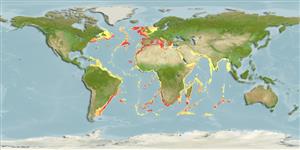Common names from other countries
Environment: milieu / climate zone / depth range / distribution range
Οικολογία
Πελαγικό(ά); εύρος βάθους 1 - 4846 m (Ref. 110525). Tropical; 58°N - 48°S, 72°W - 96°E (Ref. 106958)
Indo-Pacific, Atlantic Ocean and the Mediterranean Sea.
Length at first maturity / Μέγεθος / Βάρος / Age
Maturity: Lm ? range ? - ? cm Max length : 33.0 cm ML αρσενικό/απροσδιόριστο; (Ref. 104052)
Caught by nets (Ref. 275). Maximum depth from Ref. 1985. Oceanic and elusive. Has little interaction with the bottom (Ref. 106095). Mainly feeds on osteichthyes, followed by crustaceans (natantian), and occasionally on cephalopods. Bases their diet on pelagic nictemeral migrators (Ref. 106992).
Life cycle and mating behavior
Γεννητική Ωρίμανση | Αναπαραγωγή | Γεννοβολία | Αβγά | Γονιμότητα | Προνύμφες
Members of the class Cephalopoda are gonochoric. Male and female adults usually die shortly after spawning and brooding, respectively. Mating behavior: Males perform various displays to attract potential females for copulation. During copulation, male grasp the female and inserts the hectocotylus into the female's mantle cavity where fertilization usually occurs. Life cycle: Embryos hatch into planktonic stage and live for some time before they grow larger and take up a benthic existence as adults.
Roper, C.F.E., M.J. Sweeney and C.E. Nauen. 1984. (Ref. 275)
IUCN Red List Status (Ref. 130435)
CITES status (Ref. 108899)
Not Evaluated
Not Evaluated
Human uses
αλιεία: με δυνητικό ενδιαφέρον
| FishSource |
Εργαλεία
Διαδικτυακές πηγές
Estimates based on models
Preferred temperature
(Ref.
115969): 4.2 - 14.3, mean 13 (based on 336 cells).
Vulnerability
Low vulnerability (23 of 100).
